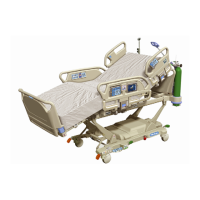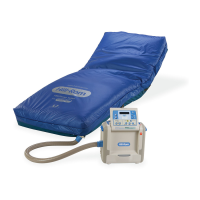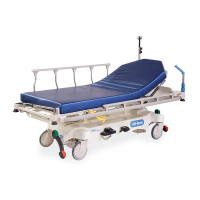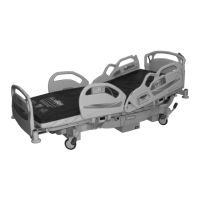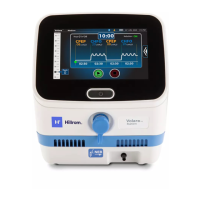Do you have a question about the Hill-Rom The Progressa and is the answer not in the manual?
Controls for adjusting head, knee, and overall bed height.
Controls for bed positions and foot section extension.
Specialized features, safety functions, and lockout controls.
Overview of GCI screen elements and status indicators.
Controls for accessing alarms, scale, therapies, and help.
Visual indicators for bed position and alarm status.
How the 'Enable' control works for temporary access.
Controls on the pendant for bed adjustments.
Procedure to unlock the Graphical Caregiver Interface.
Procedure to lock the Graphical Caregiver Interface.
Steps to zero the scale for accurate readings.
Steps for configuring the scale for a new patient.
Steps to zero the scale according to OIML standards.
Procedure to weigh a patient using the OIML scale.
Steps to zero the scale for non-OIML compliance.
Procedure to weigh a patient using the non-OIML scale.
Steps to calculate Body Mass Index using the bed's interface.
Adjusting bed height using siderail controls.
Adjusting bed height using the pendant.
Adjusting bed height using the foot pedal.
How to extend the foot section of the bed.
How to retract the foot section of the bed.
Adjusting the head section via siderail controls.
Adjusting the head section via caregiver pendant.
Adjusting the knee section height.
Adjusting the foot section height.
Steps to start Continuous Lateral Rotation Therapy.
Selecting rotation parameters for CLRT.
Steps to activate Percussion & Vibration therapy.
Configuring intensity, frequency, and duration.
Procedure to stop active therapies from the GCI.
Adapting to patient needs with Flexafoot before tilting.
Steps to activate the Reverse Trendelenburg position.
Steps to achieve the FullChair position.
Information regarding footboard installation for FullChair.
Steps to move the bed into the Chair Egress position.
Using the 'Chair' control for egress support.
How to return the bed to a level position.
Steps to enable the side exit assist feature.
Steps to disable the side exit assist feature.
Explains 'Out of Bed', 'Exiting', and 'Position' triggers.
Steps to arm the bed exit alarm via the GCI.
Steps to turn off the bed exit alarm.
How to silence or suspend the active alarm.
How to activate the CPR function using the pedal.
Steps to lock bed articulation functions.
Steps to unlock bed articulation functions.
Steps to engage the Boost positioning feature.
How to return the bed to a flat position after Boost.
Steps to activate Max-Inflate for the air surface.
Steps to return the air surface to normal.
Steps to activate assist for turning the patient to the right.
Steps to stop the right turn assist feature.
Steps to activate assist for turning the patient to the left.
Steps to stop the left turn assist feature.
Steps to deflate the seat section for bedpan placement.
Steps to engage Opti-Rest mode for increased comfort.
Steps to return to normal mode from Opti-Rest.
Steps to activate Sleep Mode for reduced adjustments.
Steps to return to normal mode from Sleep Mode.
Adjusting surface firmness for patient comfort.
Caution regarding use of Patient Comfort feature.
Steps to access various patient history metrics.
Details on Head Angle, Bed Exit, Scale, Rotation, P&V, Opti-Rest, Chair history.
Steps to view recorded weight data.
Understanding icons for initial, recommended, and non-recommended weights.
Steps to engage the IntelliDrive transport system.
Steps to disengage the IntelliDrive transport system.
Hill-Rom's recommendation regarding physical restraints.
Controls for adjusting head, knee, and overall bed height.
Controls for bed positions and foot section extension.
Specialized features, safety functions, and lockout controls.
Overview of GCI screen elements and status indicators.
Controls for accessing alarms, scale, therapies, and help.
Visual indicators for bed position and alarm status.
How the 'Enable' control works for temporary access.
Controls on the pendant for bed adjustments.
Procedure to unlock the Graphical Caregiver Interface.
Procedure to lock the Graphical Caregiver Interface.
Steps to zero the scale for accurate readings.
Steps for configuring the scale for a new patient.
Steps to zero the scale according to OIML standards.
Procedure to weigh a patient using the OIML scale.
Steps to zero the scale for non-OIML compliance.
Procedure to weigh a patient using the non-OIML scale.
Steps to calculate Body Mass Index using the bed's interface.
Adjusting bed height using siderail controls.
Adjusting bed height using the pendant.
Adjusting bed height using the foot pedal.
How to extend the foot section of the bed.
How to retract the foot section of the bed.
Adjusting the head section via siderail controls.
Adjusting the head section via caregiver pendant.
Adjusting the knee section height.
Adjusting the foot section height.
Steps to start Continuous Lateral Rotation Therapy.
Selecting rotation parameters for CLRT.
Steps to activate Percussion & Vibration therapy.
Configuring intensity, frequency, and duration.
Procedure to stop active therapies from the GCI.
Adapting to patient needs with Flexafoot before tilting.
Steps to activate the Reverse Trendelenburg position.
Steps to achieve the FullChair position.
Information regarding footboard installation for FullChair.
Steps to move the bed into the Chair Egress position.
Using the 'Chair' control for egress support.
How to return the bed to a level position.
Steps to enable the side exit assist feature.
Steps to disable the side exit assist feature.
Explains 'Out of Bed', 'Exiting', and 'Position' triggers.
Steps to arm the bed exit alarm via the GCI.
Steps to turn off the bed exit alarm.
How to silence or suspend the active alarm.
How to activate the CPR function using the pedal.
Steps to lock bed articulation functions.
Steps to unlock bed articulation functions.
Steps to engage the Boost positioning feature.
How to return the bed to a flat position after Boost.
Steps to activate Max-Inflate for the air surface.
Steps to return the air surface to normal.
Steps to activate assist for turning the patient to the right.
Steps to stop the right turn assist feature.
Steps to activate assist for turning the patient to the left.
Steps to stop the left turn assist feature.
Steps to deflate the seat section for bedpan placement.
Steps to engage Opti-Rest mode for increased comfort.
Steps to return to normal mode from Opti-Rest.
Steps to activate Sleep Mode for reduced adjustments.
Steps to return to normal mode from Sleep Mode.
Adjusting surface firmness for patient comfort.
Caution regarding use of Patient Comfort feature.
Steps to access various patient history metrics.
Details on Head Angle, Bed Exit, Scale, Rotation, P&V, Opti-Rest, Chair history.
Steps to view recorded weight data.
Understanding icons for initial, recommended, and non-recommended weights.
Steps to engage the IntelliDrive transport system.
Steps to disengage the IntelliDrive transport system.
Hill-Rom's recommendation regarding physical restraints.
| Category | Medical Equipment |
|---|---|
| Manufacturer | Hill-Rom |
| Patient Weight Capacity | 500 lbs (227 kg) |
| Integrated Scale | Yes |
| Model Name | Progressa |
| Bed Positions | Trendelenburg, Reverse Trendelenburg |
| Powered Functions | Height adjustment, Trendelenburg, reverse Trendelenburg |
| Safety Features | Side rails, brake system |
| Height Adjustment | 14" - 30" (36 cm - 76 cm) |
| Connectivity | Open architecture design for connectivity with hospital systems |
